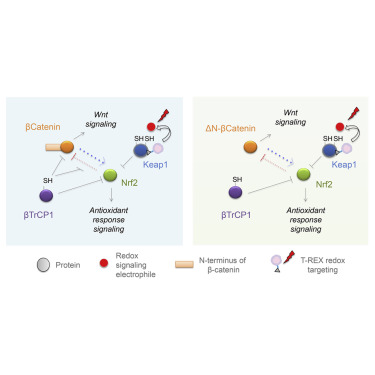当前位置:
X-MOL 学术
›
Cell Chem. Bio.
›
论文详情
Our official English website, www.x-mol.net, welcomes your
feedback! (Note: you will need to create a separate account there.)
β-TrCP1 Is a Vacillatory Regulator of Wnt Signaling
Cell Chemical Biology ( IF 6.6 ) Pub Date : 2017-07-20 , DOI: 10.1016/j.chembiol.2017.06.009 Marcus John Long , Hong-Yu Lin , Saba Parvez , Yi Zhao , Jesse Richard Poganik , Paul Huang , Yimon Aye
Cell Chemical Biology ( IF 6.6 ) Pub Date : 2017-07-20 , DOI: 10.1016/j.chembiol.2017.06.009 Marcus John Long , Hong-Yu Lin , Saba Parvez , Yi Zhao , Jesse Richard Poganik , Paul Huang , Yimon Aye

|
Simultaneous hyperactivation of Wnt and antioxidant response (AR) are often observed during oncogenesis. However, it remains unclear how the β-catenin-driven Wnt and the Nrf2-driven AR mutually regulate each other. The situation is compounded because many players in these two pathways are redox sensors, rendering bolus redox signal-dosing methods uninformative. Herein we examine the ramifications of single-protein target-specific AR upregulation in various knockdown lines. Our data document that Nrf2/AR strongly inhibits β-catenin/Wnt. The magnitude and mechanism of this negative regulation are dependent on the direct interaction between β-catenin N terminus and β-TrCP1 (an antagonist of both Nrf2 and β-catenin), and independent of binding between Nrf2 and β-TrCP1. Intriguingly, β-catenin positively regulates AR. Because AR is a negative regulator of Wnt regardless of β-catenin N terminus, this switch of function is likely sufficient to establish a new Wnt/AR equilibrium during tumorigenesis.
中文翻译:

β-TrCP1是Wnt信号的波动性调节剂
通常在致癌过程中观察到Wnt同时过度活化和抗氧化反应(AR)。但是,尚不清楚β-连环蛋白驱动的Wnt和Nrf2驱动的AR如何相互调节。由于这两个途径中的许多参与者都是氧化还原传感器,因此情况变得更加复杂,从而使大剂量氧化还原信号剂量分配方法变得无用。在本文中,我们研究了各种击倒系中单蛋白靶标特异性AR上调的影响。我们的数据证明Nrf2 / AR强烈抑制β-catenin/ Wnt。这种负调控的强度和机制取决于β-cateninN末端与β-TrCP1(Nrf2和β-catenin的拮抗剂)之间的直接相互作用,并且独立于Nrf2与β-TrCP1之间的结合。有趣的是,β-连环蛋白正调控AR。
更新日期:2017-07-22
中文翻译:

β-TrCP1是Wnt信号的波动性调节剂
通常在致癌过程中观察到Wnt同时过度活化和抗氧化反应(AR)。但是,尚不清楚β-连环蛋白驱动的Wnt和Nrf2驱动的AR如何相互调节。由于这两个途径中的许多参与者都是氧化还原传感器,因此情况变得更加复杂,从而使大剂量氧化还原信号剂量分配方法变得无用。在本文中,我们研究了各种击倒系中单蛋白靶标特异性AR上调的影响。我们的数据证明Nrf2 / AR强烈抑制β-catenin/ Wnt。这种负调控的强度和机制取决于β-cateninN末端与β-TrCP1(Nrf2和β-catenin的拮抗剂)之间的直接相互作用,并且独立于Nrf2与β-TrCP1之间的结合。有趣的是,β-连环蛋白正调控AR。











































 京公网安备 11010802027423号
京公网安备 11010802027423号